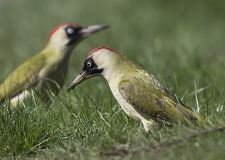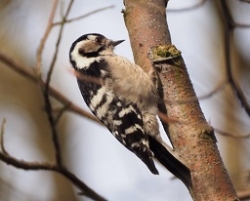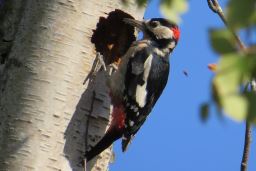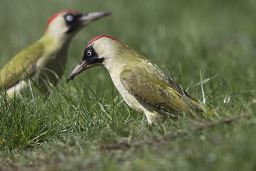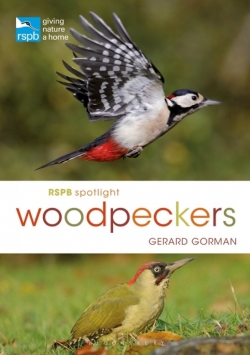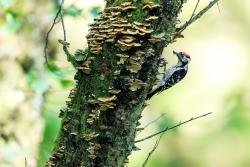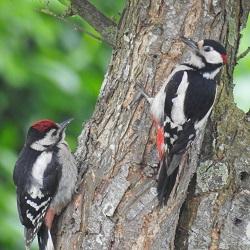Welcome to the woodpecker-network website our purposee is to encourage and facilitate the study of woodpeckers in Britain and Ireland and to provide a forum to share techniques, results and good practice. The network is co-ordinated by Ken and Linda Smith, who are based in West Sussex and Gus Robin who is based in Somerset..
The website has information on all woodpecker species found in Britain and Ireland but the main focus on the Lesser Spotted Woodpecker Dryobates minor, a species which is in strong decline compared to Great Spotted Woodpecker Dendrocopus major and Green Woodpeckers.
Is your Woodpecker a Great Spotted or a Lesser Spotted? Here is how to tell the difference
We offer support to volunteer birdwatchers nationally to record Lesser Spotted Woodpeckers and, where possible, find and monitor nests and to pool the results. We aim to promote the cause of Lesser Spots and encourage systematic recording of breeding attempts.
The project to find and monitor Lesser Spotted Woodpeckers is continued in 2024. From late February onwards please look out for Lesser Spots in your area. If you find one please record details and location. Birds found from Early March onwards are very likely to nest in that area, so if possible please follow up your sighting and look for the nest in April/May. More details on how to find and monitor nests - see also our latest Newsletter and previous years' reports on the news page.
Ken Smith's talk on The Joys and Challenges of Monitoring Lesser Spotted Woodpeckers for the Rare Breeding Bird Panel on 16 March 2023 is still available on RBBP's uTube website, Talk 10 The joys and challenges of monitoring Lesser Spotted Woodpeckers it lasts 15 minutes.
Despite huge efforts Lesser Spot Net volunteers found and monitored only nine nests in 2024. More details and information are published in our yearly Reports, the 2024 Report and Newsletter and previous years reports are available to read and download on the News page
Background This web site has been created by Ken and Linda Smith who have been studying woodpeckers for more than 30 years. A few years ago, we realised that the opportunity was being missed to collect important breeding data from Lesser Spotted Woodpecker nests found as part of normal birdwatching – either because the observers were unaware of the potential value of their observations or because the means to inspect the nest contents was not easily available.
So in 2015 we launched an initiative to help and encourage observers to find breeding Lesser Spotted Woodpeckers, where possible find the nests and to facilitate the recording of their contents and outcomes. Full details are are on the Lesser Spotted Woodpecker pages.
We had a good response and thanks to the efforts by volunteers ten nests were found and recorded in both 2015 and 2016 from as far afield as Shropshire, Lincolnshire, Devon and East Sussex. This was a big increase on the one or two reported in the previous years. Since 2015 volunteers have found and monitored over 120 nests through the Network.
The results of the first five years of the project were published in the BTO journal, Bird Study, in 2020, Long-term trends in the nest survival and productivity of the Lesser Spotted Woodpecker Dryobates minor in Britain full details of the results are in the news item Lesser Spots really are in trouble.
The project to find and monitor Lesser Spotted Woodpeckers continues in 2024 - this year Gus Robin, who is based in Somerset, is co-ordinating nest recording and monitoring in the West Counrty. More details on LSW breeding listed by county is in our 2023 Newsletter available to read and download and previous years reports on the news page.
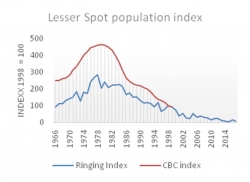 As most birdwatchers know, the Lesser Spotted Woodpecker is in serious decline in much of its British range since 1979 (see the BTO website for full details of population trends and other monitoring). By 2000, the numbers had become too low to be monitored by national surveys. The chart shows the population index derived from BTO Common Bird Census 1966-1999 (orange line) and a new estimate derived from national bird ringing records, the ratio of Lesser Spots ringed to the number of woodland birds ringed each year from 1966 to 2017 (blue line) extending the national trend line beyond the end of formal monitoring. Both indices are set at 100 in 1998.
As most birdwatchers know, the Lesser Spotted Woodpecker is in serious decline in much of its British range since 1979 (see the BTO website for full details of population trends and other monitoring). By 2000, the numbers had become too low to be monitored by national surveys. The chart shows the population index derived from BTO Common Bird Census 1966-1999 (orange line) and a new estimate derived from national bird ringing records, the ratio of Lesser Spots ringed to the number of woodland birds ringed each year from 1966 to 2017 (blue line) extending the national trend line beyond the end of formal monitoring. Both indices are set at 100 in 1998.
This and the National Atlas distribution maps for survey periods 1968-72, 1988-91 and 2008-11, (British Trust for Ornithology) show the extent of the problem.
The reasons for the decline are not known for sure but work by the RSPB between 2005 and 2009 suggested low breeding success was a possible factor (for a review see Smith et al. 2012, British Birds 105, 294-307) link to BB paper. It would be great to be able to compare the results of the RSPB work with those from the BTO Nest Record Scheme to see whether low breeding success is a general problem. Sadly, over the last few years the numbers of nest records for this species have fallen to such low numbers that this is not possible.
The primary purpose of this website is to provide support for birdwatchers to find and record Lesser Spotted Woodpeckers and where possible find nests and provide the means to record breeding success to help in the conservation of this species. All data on breeding sites and nests will be treated in strict confidence.
Find out more about British Woodpeckers - read Gerard Gorman's excellent book - Woodpeckers - in the RSPB Spotlight series - more details here
The Woodpecker-Network website is funded by Linda and Ken Smith and supported by Woodpecker enthusiasts everywhere.
